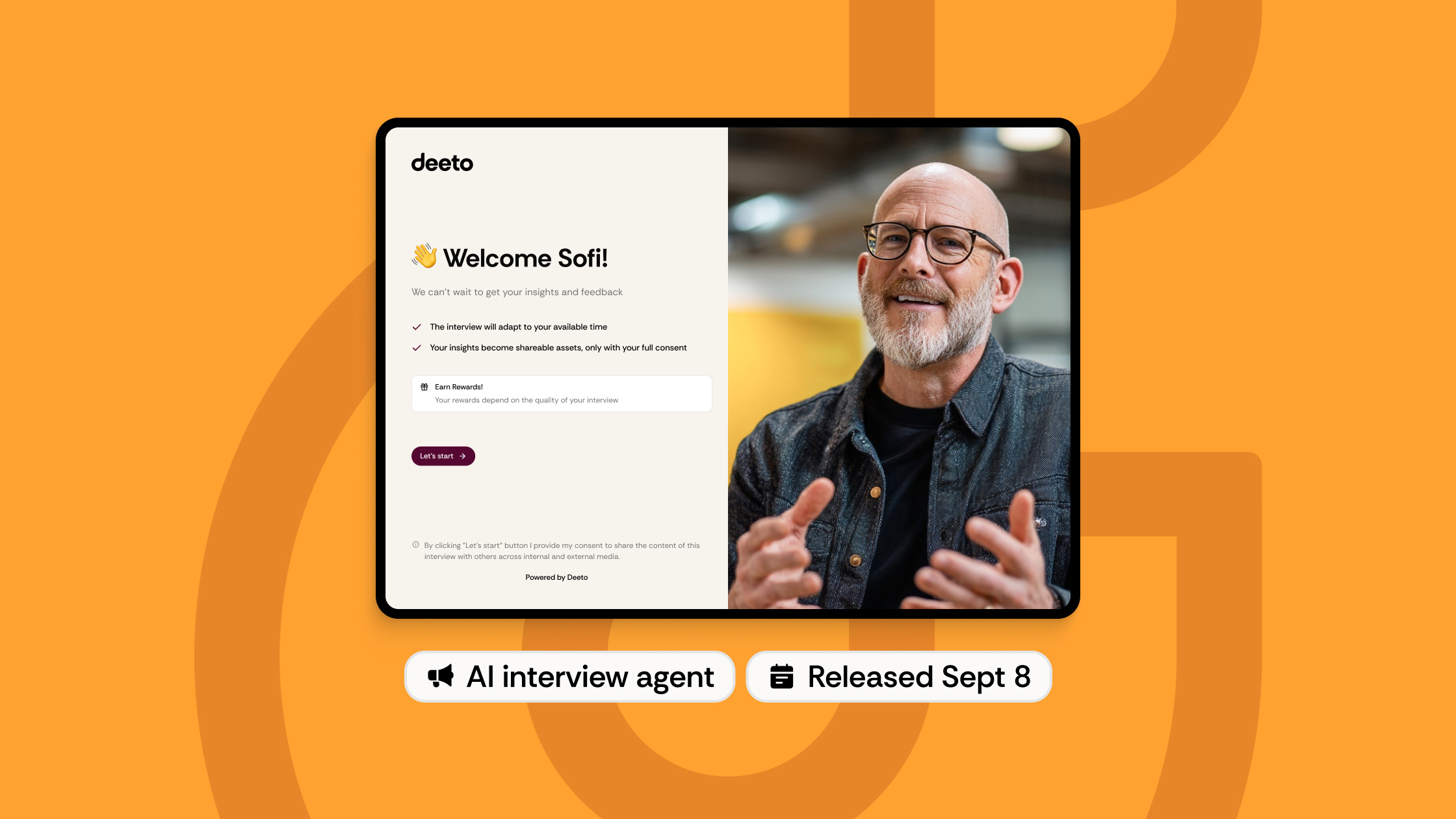Authentic Customer Voices Episode 1: Unfiltered Customer Voices - Why Polished Isn’t Always Powerful


Thursday, October 23, 2025


Authentic Customer Voices Episode 1: Unfiltered Customer Voices - Why Polished Isn’t Always Powerful






View the podcast on Youtube

Overview
In this episode of Authentic Customer Voices, Captivate Collective co-founders Liz Richardson and Deena Zenyk share why the most powerful customer stories are often the least polished. They discuss how authenticity drives trust, the importance of embedding advocacy across the entire customer journey, and how AI is reshaping what “real” customer voice means. Tune in for fresh insights on measuring impact, building genuine connections, and the future of customer-led growth.
Full Transcript
Host: Welcome to the Authentic Customer Voices podcast, where we chat with leaders who are rethinking what it means to bring real customer stories into the spotlight. Today we have not one, but two incredible guests. Liz Richardson and Deena Zenyk are the co-founders of Captivate Collective, a community helping companies build customer advocacy and engagement programs that are anything but old school.
Liz is the Chief Revenue Officer and Deena is the Chief Customer Officer. Together they bring a ton of experience in customer marketing, community, CX, and more. They have been at the forefront of pushing our industry forward, and I am extremely excited to have them with us today. Liz and Deena, thank you so much for being here.
I would love to kick things off by having each of you introduce yourselves and share what led you to start Captivate.
Liz: What an amazing story that would be. That is a whole other podcast, Shawnna, but thank you so much for having us. We are thrilled to be here. I cannot take credit for founding Captivate since Dina went forth and paved the way. I am far too fearful to do that on my own. Deena took that leap.
What led us here was the idea that advocacy is not confined to a single platform. Advocacy is a methodology and a practice. Although Deena and I both came from a platform vendor in the CMA space — you might even call them the category creator — our passion was bringing that education and methodology to anyone, whether they are using a spreadsheet or the fanciest, most expensive advocacy tool out there.
We were able to do that by going off on our own and building Captivate. Deena, I will pass it to you.
Deena: I think there is another element to why we started Captivate. We are both entrepreneurial people with a lot of ideas. When you are working inside someone else’s organization, your big ideas do not always land. They do not always have space to breathe and grow.
With Captivate, we are pulling in the best pieces of who we are and how we want to see the practice. We built the kind of business we would want to work at. That was important to us with Captivate.
Host: I love that. And Deena, you have long championed authenticity over polish when it comes to advocacy. How do you define authentic customer voice in today’s landscape?
Deena: That is a really good question. My answer is simple and straightforward.
What does the customer actually say? What do they think when it is unpolished? You have to take the good with the bad. You learn from the bad and you celebrate the good. Too often people take customer voice and put it through a blender. They grind away the rough edges and polish it up.
We are people. We want to hear real stories and be conversational. When you read five-star reviews now, you look for balance. I always toggle to most recent and then the middle of the road. I want to see the good, the bad, the ugly, and the unpolished.
Liz: I agree. I go immediately to the three-star reviews to understand where that middle ground is.
Host: Liz, from your client work, where do you see the biggest gaps between how companies say they use customer voice and what they are actually doing?
Liz: First, I will acknowledge that in B2B SaaS we have won the battle of agreeing you need customer voice, at least in marketing and sales. We have gotten better at putting forward advocates and happy customers and infusing that authentic voice, polished as it may sometimes be.
The gap is in bringing that idea across the entire organization. People talk about being customer led, but they are not infusing customer voice into all aspects of the business. For instance, in my last role leading the CS team, no one was talking to customers when they decided to leave. We were not having sit-down exit interviews and then bringing those themes back to the team.
A survey is a great starting point for data, but what are the qualitative points when we sit down and talk to them? All the way to events. You may have a great customer event, but are you infusing customers as the leading voice? When you do a product launch, where is the customer voice on why a feature was brought forward, who wanted it, and how they will use it to be successful?
We are doing a better job capturing voice with new tools, but we are still missing the tried-and-true best practices and methodology of leveraging customer voice across the entire journey to impact and grow the organization in meaningful ways.
Host: I could not agree more. Advocacy does not belong in a silo. Deena, from a best practice perspective, how do you see advocacy and customer voice embedded throughout the customer journey?
Deena: We have a methodology we call lifecycle advocacy. It moves advocacy from a place you go to access opportunities into opportunities being served up at the right time, in the right channel, to the right customer.
You look for signals and triggers that tell you who is the right customer to send for a peer review, or when is the right time to ask someone to participate in a piece of customer evidence or a story. Too often advocacy lives in a silo, and sometimes it even lives only in a practitioner’s head.
Lifecycle advocacy removes guesswork and boundaries. It asks for a holistic picture of the customer. Where are they in their product adoption journey? What is the health of the account? How often are they interacting with us, our content, or other opportunities? Let that guide what you put in front of them.
Host: Amazing. Liz, you have worked with a wide range of B2B organizations. What are some of the most creative or effective ways you have seen brands bring authentic voice into their go-to-market motions?
Liz: One that immediately comes to mind is Amplitude’s Aha campaign. Instead of capturing another case study, they created a holistic campaign. They asked customers to sit down and tell them the aha moments they had with the product. When you combine those moments under a single theme, the impact is amplified. It signals that when people use the product, they are delighted and have impactful moments.
That is a great example of rethinking how customer voice is brought into GTM. We also see vendors making progress on letting prospects self-serve their reference experience and hear from customers at the point of need. We have to rethink how people consume content, how they hear about products and services, and how we empower advocates in those moments.
Deena: I will add that authentic does not have to mean non-anonymous. We are seeing the rise of anonymous or blind material where a customer story is told without naming the brand. That piece can be used publicly, and then the person or brand can be revealed later in a smaller or more private setting. It is still very authentic.
More broadly, I co-authored a book called The Messenger is the Message, and that remains true. Organizations that position customers as the conduit of the message will be heard above the noise. We have to get out of the way and let customers be the messenger. People are skeptical of brands.
Host: Absolutely. Deena, you started to allude to metrics and proving impact. What metrics matter most when it comes to showing the business value of customer voice?
Deena: We think a lot about leading indicators versus real business impact. Advocacy has been comfortable talking about leading indicators like how many case studies, how many program members, and overall engagement rates. The leap is connecting a piece of content to dollars and cents. Or connecting program membership to business impact.
Often teams are already showing impact, but they are not telling the right internal story. We helped one customer reframe her reporting and it moved advocacy forward inside the business. If you are unsure what business impact means at your company, look at what CS, Sales, and Marketing are held accountable to. That will show you where to hitch your metrics.
Liz: To get specific, we all end up measured on revenue growth and retention. Customer advocacy and marketing do not own those numbers, but they can influence them. Consider what portion of your revenue base you are touching through your programs. Where are the second connections you are bringing in?
If you can, measure upsell, cross-sell, and account growth of customers in your programs against a sample of customers not in your programs. Do the same for retention. If you have one person in a program, two, or three, does churn risk go down when you are multithreaded across programs, perhaps with an executive in one and a champion in a user community?
This is hard to measure and there are blockers, especially at larger organizations, but it is the right work. Do not forget efficiency. How much cost are you deflecting by leveraging customers to amplify social presence or deflect support tickets in community? Start measuring real dollars and cents and stop resting on vanity counts like total reviews alone. Your CEO will need more than that.
Host: Really concrete advice. Thank you. We all know AI is changing how we engage with customers. How do you see it helping or hindering authentic customer voice?
Liz: We do not fully know yet. Over the past several months, I have noticed a general questioning of authenticity in everything. I read something and wonder whether it was written by AI, supplemented by AI, or a person’s real thoughts and expertise.
If AI outputs are polished, maybe we will see a rise in organizations letting go and leaning further into unpolished, real content. To demonstrate authenticity, you have to allow the good, the bad, the ugly, and the wonderful to coexist. That might make readers less skeptical.
Deena: I think there will be a lot of positives. How much voice can we capture and lift up? Deciphering customer voice used to be a heavy lift. Now we have a powerful machine to do some of that work so we can get to the truth and the nuggets faster.
We will see customer-generated content triple because of the speed. Creation and syndication will happen in minutes. The fun begins as organizations figure out how to make their customer content stand out in a sea of it. We will come back to familiar questions about breaking through brand noise and now customer noise. Brands have empowered customers to share. With AI in place, we need new best practices to rise above.
Host: We are coming up on time. One last question for each of you. What is your bold prediction for how customer voice and advocacy will evolve in the next few years?
Liz: There is a lot of gray area among customer marketing, customer experience, and customer success. As we break down silos, where is the line? With community also entering the conversation, my prediction is these groups will roll up under single leadership and work more closely together. They will need to be one team rather than competing for ownership.
Deena: My prediction may be scandalous. In the next few years, we will stop paying attention to B2B peer review sites. We have created a crisis of trust by chasing only five-star reviews, over-incentivizing, and over-indexing on review volume. The skepticism we see in B2C has come to B2B. I do not see review vendors making changes that reverse the sentiment. That will open space for something new to take root. I do not know what that is yet, but I do not think peer review sites will command the same focus.
Host: I love those predictions. Liz and Deena, thank you so much. I appreciate you joining us and sharing thoughtful perspectives on what it means to embed customer voice across the entire journey. To our audience, if you found this valuable, follow along for more episodes with leaders who are shaping the future of customer-led growth.
Thank you for listening, and we will see you next time.
🎉 Save your spot
Register for the event
Once your spot is secured, we’ll send your confirmation details.
Table of contents
Subscribe to our newsletter
Subscribe to receive the latest blog posts to your inbox every week.
By subscribing, you agree to our Privacy Policy
Subscribe to our newsletter
Get the latest news and updates from our team.
By subscribing, you agree to our Privacy Policy


